Chapter Twenty-Eight
Timeless Legacy
In the spring of 1987 Gurudeva’s vision for Iraivan Temple was evolving from a mystical revelation to a real-world plan. Working with sacred architects in South India, he was defining its physical form, establishing the principles of its creation and considering the style of the massive stone edifices built during South India’s Chola Dynasty a millennium ago. The big question was still pending: What form of Siva would inhabit the inner sanctum? It was a meditation that continued for months, for he knew the relevance of this decision. It would define the temple more than any external style. It would be its life and essence, the most holy and powerful force around which all else would circle.§
A Clear Crystal Vision
One day, in an early-morning vision in his private quarters, Gurudeva saw the future, as he would later say. In fact, he often said, if you want to know what you should do, do this: In your mind, travel into the future, and from there look back and witness what happened. The present-day decision will be obvious.§
In this vision of the yet-to-be, Gurudeva saw a massive crystal Sivalingam shining brightly in the sanctum of Iraivan Temple, radiating out to the world. It was a titan among crystals. In fact, it seemed in this first seeing impossibly large, fantastical and beyond reality. Perhaps, he thought, it is merely the spiritual form of the Sivalingam and not the physical one. §
Downstairs a few hours later, he shared this vision with the monks, letting them know he had his answer as to which form of Siva that Iraivan Temple would embody. It would be a crystal Lingam, known in Sanskrit as sphatika Sivalingam. In the ancient texts it is said that a Lingam, which is the aniconic form of the Creator-Preserver-Destroyer of the universe, is the highest of worshipful icons. It represents That which is beyond representation, beyond form and even imagination. It is the All in all, the Self beyond time, form, space and cause. §
The Agamas say one can worship this Great God Siva in the form of a Lingam made of mud or sand, of cow dung or wood, of bronze or black granite stone. But the purest and most sought-after form is the quartz crystal, a natural stone not carved by man but made by nature, gathered molecule by molecule over hundreds, thousands or millions of years, grown as a living body grows, but infinitely more slowly. Such a creation of nature is itself a miracle worthy of worship. §
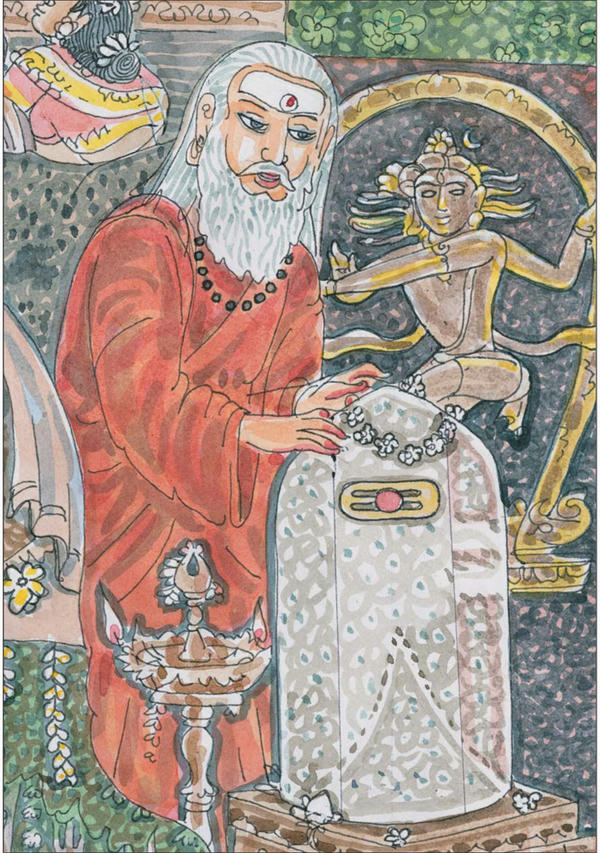
An early morning dream of a perfect crystal Sivalingam led Gurudeva to a giant, six-sided, single-pointed sphatika. Unearthed by miners in 1975, the same year as his vision of Iraivan, it arrived on Kauai in 1987.
• • • • • • • • • • • • • • • • • • • • • • • •§
The monks were delighted to hear of their guru’s revelation and imagined the meanings behind it. Kadavul Temple already housed God Siva as Nataraja, the divine dancer who creates and inhabits every atom of the cosmos, and Iraivan Temple would host Siva as the transcendent Beyond, immanent and transcendent, form and formless. It was perfect. But the monks were not at all prepared for what would happen next. §
Gurudeva paid a visit the next day to the Crystal Journey shop at Kilohana on Kauai. He was there looking at the wares, asking the proprietor about crystals, looking for a large one he had visualized. She did not have such a crystal, but eagerly shared her own similar vision of a giant crystal.§
Some weeks later, she called requesting to meet with Gurudeva, arriving at the monastery mid morning. She was a kind of mythical character, a child of the 70s, a cherubic, intelligent lady about 40 years old. In her long dress, looking a bit Roma, her round cheeks pink with the pleasure of her visit, she shared that she had an important message for him. She was taken to Gurudeva’s office, where he listened to her tale. “Gurudeva, I had a dream last night. In my dream I saw, even more clearly than before, a giant crystal. Very tall and perfectly formed, just like the one you described. Not only that, I saw where it is. If you will allow me, I want to go there. I want to find the crystal and bring it to you. Will you buy me a ticket?”§
Never in his life had Gurudeva bought a ticket for a near stranger on a dream-induced mission. But this was different. Gurudeva then told the visitor of his own dream that same morning, of how he had seen the giant crystal, too, but never imagined someone else might have the same dream at nearly the same time. He took it as a sign, and did the unthinkable—bought her a round-trip ticket to Arkansas, the Natural State. §
Soon she was on a crystal quest. Having never visited Arkansas, she took the logical course and began visiting the various mines in the area. Along with Brazil, Arkansas is the world’s most productive crystal source, and there were dozens of mines to be tracked down at the end of long, unpaved roads.§
Ultimately she found the crystal at the mines of one James Coleman, a hard-scrabble man dressed in denim with a scrappy beard and callused hands, whose father and grandfather had mined crystals and who knew the business like none other. §
Ambling to his Jeep, the taciturn miner motioned to her to get in. Off the two drove, about a mile on a pitted coral path some called a road that ended at an old wooden warehouse. Getting down, Coleman walked through the double doors and headed to the back of the open space, stopping at a pallet in a dark corner. On it was a musty mattress, worn and worthless, rolled in a circle and tied with a hemp rope. §
Without so much as a word, Coleman cut the rope with a pocket knife and threw open the mattress. There lay the huge, milky white, quartz crystal. It was a marvel to behold, a perfect thing that could be an artifact in a museum of art or a masterpiece in the foyer of a billionaire’s mansion. But it was here, not far from nowhere.§
His customary reticence overcome by the urgent need to relate his story, Coleman turned to the woman, who stood speechless, with happy tears washing down her cheeks. §
In 1975 my brother and I were digging for crystals. Below these hills there are honeycombs of caves where our rocks are harvested. We were 65 feet under that day, when we found our way into a new cave. Nothing unusual about it at first; it was some twenty feet across and five feet high, all dark and dank. But then our light fell on this crystal. It had fallen and lay on its side, broken away from the cave floor. Around it on three sides was a colony of smaller crystals, ten or so, which were all still intact and growing. This one had stopped growing, of course. As you can see, it has six sides and is perfectly pointed, and its surface feels like cool ice, day and night. We went up to get the mattress and wrapped the crystal in it, dragging it inch by inch to the surface. Took all day. §
It was, to both of us, an amazing discovery. Though our family has been mining crystals for three generations, no one ever heard of such a gem. My brother and I knew it was one of a kind, and we both sensed it had a destiny, though we didn’t know what that might be. Something extraordinary. We kept it in the mattress and brought it here, out of sight, vowing not to tell a soul about it. But somehow you saw it. How else would you know? We figured that one day we would learn what the crystal was meant for. I think it was meant to go with you, to Hawaii, and to be with that holy man who saw it. The crystal has been waiting, and I’m glad you came to get it.§
The crystal seeker was exultant. She called Gurudeva, who asked for photos to be sent. When he saw them, he said, “Yes, that’s it!” She arranged for the purchase and packing of the crystal, then flew home. The 700-pound, 39-inch-tall sphatika Sivalingam arrived at the monastery on August 14 and was formally installed in front of Lord Kadavul Nataraja two days later, awaiting the day Iraivan Temple would be completed. Gurudeva’s morning vision had manifested in a magical way. §
One afternoon years later, a deva with whom Gurudeva often communicated signalled that he was present and asked if there were any questions. The monk with him asked about the significance of the huge crystal. With the same ease that ordinary people listen to a friend speak, Gurudeva clairaudiently heard the inner-plane deva’s answer and dictated it, in two- and three-word volleys, to his amanuensis of the day.§
Now, the large crystal we have is very special, having been especially prepared for its mission as a relay station for peace on Earth, harmony, contentment, healing and patience, freedom and goodwill and close cooperation among the life forms and humans beings on this planet. It is at this very moment relaying trillions of messages through every crystal on this planet, energizing and educating even the smallest insect. §
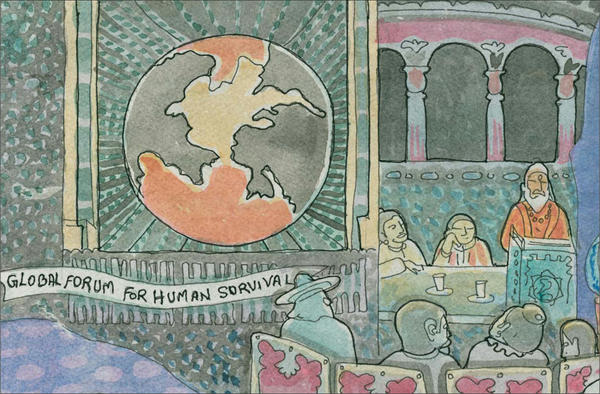
For five days in 1988 Gurudeva met with spiritual and political leaders at Oxford University, bringing the tolerant, all-embracing message of Hinduism to a forum that included the Dalai Lama, the Archbishop of Canterbury, Cardinal Koenig and leaders of every major faith, joined by ranking politicians, media and scientists.
• • • • • • • • • • • • • • • • • • • • • • • •§
Fighting for Peace and Human Survival
Gurudeva’s global renown grew steadily. In 1986, the World Religious Parliament in New Delhi named him one of five modern-day jagadacharyas, world teachers, for his international efforts in promoting a Hindu renaissance. That award and other messages made it clear to Gurudeva that he was being embraced by the East. In fact, he was being anointed as the first Western person ever to be regarded as a satguru, that highest of spiritual offices, heretofore reserved, even guarded, for men of Indian origin. It was an honor; but more importantly, it was a responsibility, one that he never took for granted. It was also a double-edged sword, for there was a conservative coterie of Indians who could never accept the idea of a non-Indian rising to prominence as a guru, whose feet they were obliged to touch. They kept their distance, holding a critical watch.§
Gurudeva only occasionally attended conferences, though he was often invited. He found a handful deeply significant: the Global Forums of Spiritual and Parliamentary Leaders on Human Survival in Oxford (1988), Moscow (1990) and Rio de Janeiro (1992), the Parliament of the World’s Religions in Chicago (1993) and the Millennium World Peace Summit of Religious and Spiritual Leaders, held at the United Nations (2000). §
If man finds the fear of his own death difficult to confront, consider the possibility that the human race itself is in mortal danger and could perish forever. That was precisely the enterprise for which approximately 140 of the most influential men and women from sixty nations gathered at Oxford University in England from April 11 to 15, 1988. Astrophysicist Dr. Carl Sagan, biologist Dr. James Lovelock, Soviet nuclear scientist Dr. Yevgeny Velikhov and other preeminent experts in population, media and education presented a litany of ominous threats. Humankind had awakened to the terrible revelation that the Earth and its tiny cargo of living things are vulnerable—that unless something is done soon, one day man himself, like tens of thousands of species disappearing each year, may become extinct.§
Not since the Middle Ages had legislators and spiritual leaders met at such a level, and then it was limited to European statesmen and Christian leaders. The 1988 Global Forum brought together representatives of five major faiths—Hinduism, Buddhism, Christianity, Islam and Judaism—as well as African and American Indian religions, Jainism, Sikhism and Shintoism.§
What are the problems that endanger us? In no particular order: war, hunger, poverty and inequity of resources, debt, drugs, desertification, illiteracy, population growth, religious fundamentalism, global warming, disintegration of ecology, loss of species and social injustice.§
As the five days unfolded, it was evident that delegates shared the urgency voiced by Austrian Cardinal Koenig: “We have come together to find ways out of crisis. There is only one choice: to survive or perish together.” To this Robert Runcie, Archbishop of Canterbury, added: “There are two qualities for survival, reverence and cooperation. We need to control our spiritual hubris. We need to cease believing this is a cheap, throw-away universe in which everything but human life is expendable.” Africans stressed the vast schism that exists between rich and poor nations, decrying “excess materialism and unbridled consumption.”§
The Dalai Lama’s presence caused the biggest stir, partly because his unadorned talk of love and compassion cut to the core of the human dilemma, pointing to the heart as the place to transform both self and world. His message of mutual respect and understanding, of resisting the urge to propagate one’s faith and to replace it with a desire to contribute usefully to humanity as a whole were messages needing to be heard. For this, the exiled Buddhist god-king was the perfect spokesman. §
Gurudeva created quite a scene when one of the religious leaders was slighted at a plenary session opening blessing. After an eloquent African priestess concluded the prayer, the panel moderator said, “Now let’s get on to the real business of the day.” Gurudeva boldly stood among them and took exception to this remark, telling the organizers that they had invited the spiritual leaders to work with the political leaders, but instead had them come up and give some little prayer, then insulted their presence and diminished their participation. “This priestess is the real business of the day,” he scolded them, his long arm held aloft, “as much as everything else, and you’ve really offended every spiritual tradition by pronouncing that we’re just here as wallpaper to your meeting. That’s not why we came here.” The chairperson apologized, first from the podium and the next morning in person. She and others realized he was right, and they had met to change their habits. It was a crucial moment in the conference, and the rest of the week spiritual leaders were eagerly brought forward and properly honored.§
In 1990, Gurudeva again joined the world’s religious and political leaders, this time for a seven-day sojourn where ice and snow were the prime physical reality and the sun was never seen. Imagine a room roughly the size of an airplane hangar filled with 1,400 beautiful and colorfully-costumed souls from every corner of the globe, all discovering their shared cosmology, all remembering that this fragile Earth is our only home, all learning how we have foolishly polluted our only sanctuary and all determined to protect it. Imagine that, and you will have a good idea of what the Global Forum experience in Moscow was all about.§
We were invited to the Global Forum of Parliamentary and Religious Leaders in Oxford, in Rio de Janeiro and also in Moscow. All of our invitations were handled in this way: “If you want us, we’re ticketless travelers. We are renunciate monks and don’t have a travel budget. Send tickets and we’ll be there.” It seems they wanted us there so badly, for some reason, that tickets arrived. The tickets either have to be first class or business class, because I don’t fit into those little seats anymore. They’re getting smaller and smaller and smaller every year.§
The strong delegations of indigenous peoples there—from Africa, North America, Hawaii and elsewhere—reminded Gurudeva of how valuable these traditions are and how much they are still ignored and abused. They are like fragile cultural gene pools, seeds of an earlier wisdom that mankind once amassed, then squandered and now needs to sow again. One elder rightly suggested that we are all Earth’s indigenous people. It was clear to Gurudeva that Hindus are the natural allies of these traditions, and that we should, without imposing, offer them resources they might find useful and speak up on their behalf.§
The Global Forum in Moscow, funded by the Russian government, was also about learning that man has become the major predator on the Earth, so much so that he is preying on himself in an unnatural cannibalism. Unless the present course is altered, scientists urged, we may be responsible for a kind of unintentional suicide. What Gurudeva heard in Moscow could be summarized: If we don’t change our attitudes, if we persist in our present habits and practices, we will not thrive, we may not even survive. It can be said even more simply: Change or perish. The Earth will heal once we stop hurting it. Wars, pollution, species extinction and fundamentalism will cease when they are no longer acceptable to human conscience. And they will no longer be acceptable the minute we understand their terrible results. §
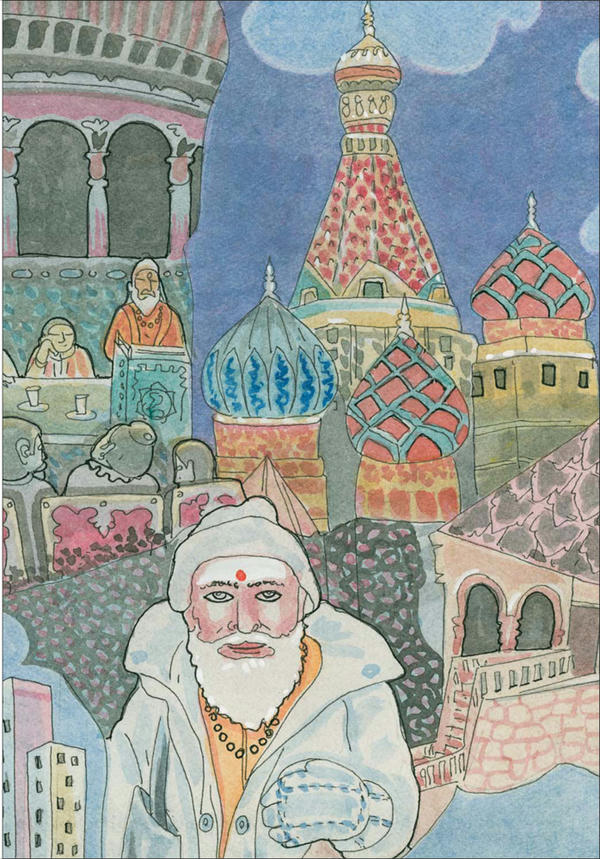
In the frigid winter of 1990, as the USSR was breaking apart, Mikhail Gorbachev invited 700 politicians and 700 spiritual leaders to Moscow for a week-long forum. Gurudeva was among the Hindu leaders.
• • • • • • • • • • • • • • • • • • • • • • • •§
Gurudeva loved his days in Moscow, even the awkward evenings when he and the swami with him were asked to join, in their simple, unsewn monastic garb, a concert and cocktail party in the dazzling 150-year-old Kremlin reception hall and hobnob with the leaders of the world.§
On one evening toward the end, the Russian government held a grand ball in the Kremlin, inviting business and cultural leaders to join the men and women who had come from other lands to face the future of humanity. Interestingly, as each of the earlier days had unfolded, religious leaders had vied to give the opening blessing, fighting, sometimes furiously, to be chosen. All but the Hindus, who stood aside, witnessing this jockeying for pride of place. After five or six days, all of the major religions had had their turn, except the Hindus. So, a Hindu leader was selected for this night, which turned out to be the most important of them all. §
It was to be Swami Paramananda Bharati, a Shringeri monk who had been a physicist before renouncing the world. Swami approached Gurudeva during lunch, concerned that his message might not be fully understood by this diverse group. Gurudeva gave him courage to speak out boldly to the world, assuring him that the message would be clear to all present. §
That evening, dressed as Adi Shankara himself had dressed, danda in hand, three stripes of vibhuti on his arms and forehead, a picture of purity and simplicity in that formal room, Swami removed his slippers, strode to the podium under the gaze of 300 TV cameras from all over the world and began his invocation. §
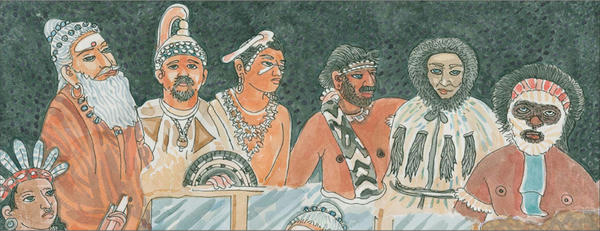
Indigenous peoples held a special place in Gurudeva’s heart. He met with Brazilian and African tribals, invited Inuit elders to help him found a temple in Anchorage and visited with Hopi elders in Arizona, putting their sacred texts online to help preserve a fading culture.
• • • • • • • • • • • • • • • • • • • • • • • •§
We are in an age of disillusionment, confusion and panic. We do not know from what point to commence our journey to enlightenment, in what direction and at what speed. Fortunately, there exists one course of knowledge which determines all of these parameters. That is the immortal Veda. Here I give two hymns from the Veda. These are prayers to the Gods pervading the various celestial bodies like the sun, the moon, the stars—nay, all the five elements of the environment. Herein we pray for shanti, that is for peace in the kingdom of the animals, like cows, peace in the kingdom of the humans. Let this shanti, this peace, descending by the grace of God, reverberate in the depths of our hearts to give each one of us everlasting bliss. Let it augur peace and prosperity to the leaders and to the people of this great nation, our host country, to the rest of the world and to the Global Forum.§
Swami then chanted, his sweet Sanskrit filling the Kremlin Hall. He closed by asking all present to join him in saying aloud “Aum,” the all-encompassing sound, three times. Swami chanted “Aum” and lifted both hands to invite all to join. A deep, resonant Aum filled the chamber. A second time and then a third the Swami chanted and the audience responded, each time more forcefully. It was a powerful moment, as though the whole world was chanting together, sharing a language that all understood, that transcended their differences and arose from their underlying oneness. Gurudeva later said that, mystically, the “Aum in the Kremlin” was the force that let loose the remarkable changes in the USSR that, unbeknownst to all present, were soon to follow. He told of the experience in HINDUISM TODAY:§
Who could believe it? Over two thousand spiritual and political leaders and guests, seated in Lenin’s Kremlin, Khrushchev’s Kremlin and now Gorbachev’s Kremlin, all hearing a shanti chant from the Vedas and all chanting “Aum” aloud together, led by a swami from India. That Aum was a war-shattering cry for peace, but sadly it was ignored in the US press, except for a trivial reference in Time magazine. So many important and high-minded people were there—including Gorbachev and Scheverdnazy, including the world’s most influential rabbis and imams, priests and swamis, monks and theologians, not to mention politicians from the parliaments of 57 nations, scientists and environmentalists, artists and media pandits. It was perhaps the first global council for the human race, all working for peace, all chanting the sacred Aum mantra of Universal Oneness in a single, melodious voice.§
Having the opportunity to meet many young Soviets in their early thirties and even in their teens, we observed a surprisingly mature interest in yoga, meditation, the occult, mysticism, crystalogy and clairvoyance. Many people don’t know that Soviet scientists and Hindu yoga adepts have been collaborating for the past two decades in mental telepathy and other extraterrestrial sciences to increase the communication faculties of the human migration into space (and for less noble purposes, too). §
Despite the -10°f winter (for which our hand-woven cotton robes were not designed) my personal experience in Moscow was warm, vibrant and full. I enjoyed attending Russia’s first public Christmas celebration in seventy years. I also enjoyed speaking with the spiritual old friends we had made at the Oxford Global Forum in April of 1988. The spirit was one of hopeful eagerness. §
As a species, we have essentially proven ourselves fully capable of seeking pleasure, of lack of concern for others and a general disregard for the concerns of the day until the reality of some emergency is upon us. The two global forums laid out the entire emergency that humankind is facing on this planet, factually and without exaggeration. It is a sad list of problems, but the spirit in man is more powerful than any challenge it ever faces, and I found hope in seeing these eminent world leaders tear themselves away from pressing responsibilities to fly to Moscow in the middle of winter and spend seven days living together, eating together, talking together, liking and learning to love and trust each other, listening together, questioning, sharing knowledge. Both the seriousness of our plight and the sincerity of people to cooperate in resolving things emerged. Because these are the leaders of humankind, their voices will be heard back home. Every member of their parliaments or their congregations will know and understand the message, and the scientists who were present will share it with all their colleagues. §
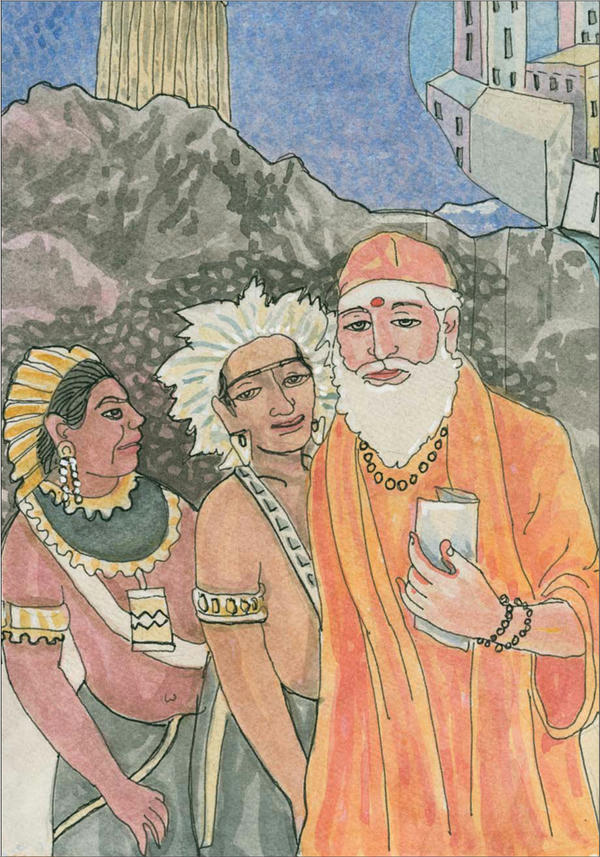
At the 1992 Global Forum in Rio de Janeiro, Gurudeva was pleasantly startled to hear the world religions all saying, “Everything is divine. We are all one.” Brazilian tribals wanted their picture taken with the tall swami from Hawaii.
• • • • • • • • • • • • • • • • • • • • • • • •§
The truth, without exaggeration, finally came out, and the solution was clear. They say when a problem is adequately explained and understood, the solution is self-evident. The solution is simple, and it rests on the shoulders of each human: think globally, act locally to restructure one’s own home, one’s own values, one’s relationship to nature for a purified, sustainable environment.§
We took our own message to Moscow, of course. It was a plea for the world to rediscover the ethic of nonviolence, called ahimsa in Sanskrit. We need to be very practical and not just philosophical about this. World peace begins in the home. Families must learn to be peaceful, to settle all arguments and contention before they sleep at night, even if they stay up for three days, so the children can see that peace can be attained and then maintained through the use of intelligence. It is up to the parents to create the peacemakers of the future. And we teach children in only one way—by our own example. §
Parents must teach children to appreciate those who are different, those who believe differently. Teach them the value of human diversity. Give them the tools to live in a world of differences without feeling threatened, without forcing their ways or their will on others. This is the way of dharma.§
I also spoke about how we should bring the mother spirit forward and seek out the guidance and intuitive knowledge of our women. If the Hawaiian mothers, the African mothers, and all the mothers of the planet come forward, then we can realize a global peace. We are too deep into the Kali Yuga for men to make a difference. They tried. The mothers, daughters, sisters and wives—who have a great ability to heal, to harmonize and influence—will bring us into the Golden Age. Give them more power in the struggle for peace.§
Nonviolence should be redefined to include not only killing, but also causing injury physically, mentally or emotionally, even in the most subtle ways. We can injure ourselves, we can injure our environment, we can injure nature’s other creatures and thus be a source of pain and sorrow. Or we can live a harmless life and be a source of healing and joy.§
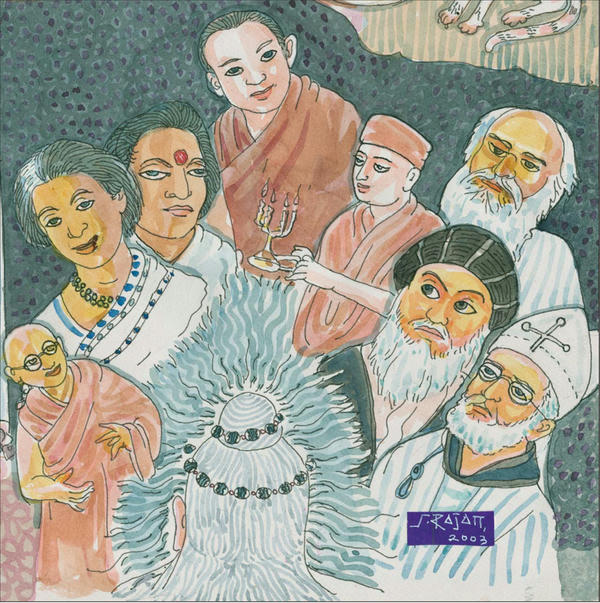
Everywhere he traveled, Gurudeva sought out leaders of all faiths, making connections to strengthen tolerance and understanding—from the Dalai Lama to the Grand Mufti, from Anandamayi Ma to Pramukh Swami to Chandrashekharendra Saraswati.
• • • • • • • • • • • • • • • • • • • • • • • •§
The sages and illumined ones knew all about karma. They full well knew that what we have done to others will be done to us, if not in this life then in another. They knew that violence which one commits will return to him by a cosmic process that is unerring. §
There was a strong influence of Eastern thought and perception in Moscow. While a few Semitic leaders spoke about man’s relationship to the natural order as one of dominion, the Buddhists, Jains, Sikhs and Hindus came forward and spoke of the wonderful oneness that makes up life. They explained that a sense of domination offends the oneness and perpetuates wrongful and harmful action. From the Eastern viewpoint, everything exists within a divine law and order, and no creature has more right to life than another. They said it is for us humans to adjust to being a part of the greater whole which sustains life, which is intricately interwoven and interdependent.§
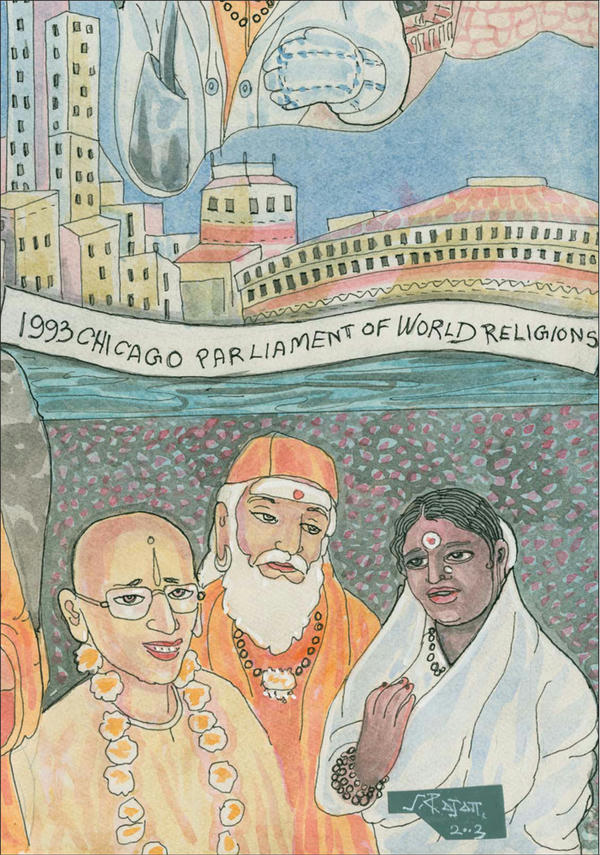
At the 1993 Parliament of the World’s Religions in Chicago, which marked one hundred years since Swami Vivekananda’s powerful message to the West, Sivaya Subramuniyaswami, Swami Chidananda and Mata Amritanandamayi were elected the principal representatives for Hinduism.
• • • • • • • • • • • • • • • • • • • • • • • •§
On the final day, Gurudeva was dining in one of the dozens of restaurants in the Rossiya Hotel. The staff all knew this was the Forum’s last day, so everyone was flying home. The waitress glanced again and again at Gurudeva’s warm, gray boots, which he had brought in anticipation of the frigid winter. When offering the check, she boldly shared that her family was suffering. In broken English, she softly asked if she could have the boots for her husband. Gurudeva, seeing her noble desperation, removed them and asked the monk traveling with him to remove his, handing two pairs of boots to a thankful waitress and walking back to his room in his socks.§
While he found value in these major conferences, Gurudeva also found the meetings inefficient, boring, repetitive and woefully lacking in follow-through. He complained about meeting the same people time and again, making the same well-meaning resolutions, then forgetting all about it. After the 1993 Chicago Parliament of the World’s Religions, he tried to keep the group of twenty-five “presidents” of religion going, of which he was one of three Hindus. He felt this group could occasionally make strategic statements on important issues. But there was little interest beyond his own efforts, and nothing came of it. It made him wary of future involvements of this kind. §
Dr. Kusumita Pedersen, a devotee of Sri Chinmoy on the staff of the Global Forum, Parliament and Millennium Summit at the UN, commended Gurudeva’s participation at these international conferences for “his powerful spiritual presence and his great clarity and commitment in engaging the issues. Also, his behind-the-scenes contribution has made a little known but historic difference to the development of interfaith work in the last generation.”§
When the third Global Forum for Human Survival was announced, a wealthy Hindu, realizing his faith yet had no substantial representatives, sponsored Gurudeva’s 1992 trip to Rio de Janeiro. This was a smaller event, about seventy-five religious leaders in a dialog with three hundred parliamentarians. Apart from the usual things you would expect from such a gathering, something quite unusual, maybe even extraordinary, took place there. Gurudeva was not really prepared for it, nor was it on anyone’s agenda. But it happened.§
From the opening address by a US Senator to the closing remarks by religious leaders three days later, virtually everyone acknowledged the sacredness of existence. It was not just the Hindus, Jains and Sikhs who were saying these things. It was everyone. Politicians propounded it. Business people professed it. Priests preached it. Musical poets praised it. It ran like a golden thread through every speech, through every call for a change in human behavior. §
Gurudeva was amazed and thrilled by this common mantra. Such a thing had not happened at previous Global Forums. In Rio it was being said loud and clear: Nature is sacred. Life is sacred. It is a desecration to destroy this precious and holy creation. It is a sacrilege which, if continued, will surely end in our own death as a species.§
Senator Al Gore, who approached Gurudeva and shook his hand, spoke of the wrongful “assumption that we are somehow separate from nature.” Brazilian Archbishop Camara made this rather stunning statement: “We are inside God. How can I hate if I am part of God? This is incredible, but true. If God is everywhere, it means we are inside God, and we have God inside ourselves.” India’s Bishop Gregorius spoke of “immanence and transcendence.” African priestesses shared the vision that life is sacred, plants are sacred, animals are sacred. Jain leaders called for reverence of all forms of life. Jewish theologian Dr. Susannah Herschel noted, “Too many religious leaders present God as remote and transcendent.” Acharya Sushil Kumar led a meditation, “Go deep and deeper. Feel oneness with all living beings.” §
It was a virtual assumption in Rio: “God is everywhere. Life is sacred.” This will seem a normal insight to our readers, and on an individual level it is. But coming from every corner in Rio, it took on the empyreal visage of an Earth-wide revelation, the gospel according to everyone, the new spiritual consensus. No one really commented on it. It was one of those things too obvious to speak of. Like the air, it was everywhere, its invisible presence firing the furnaces of confabulation—unnoticed.§